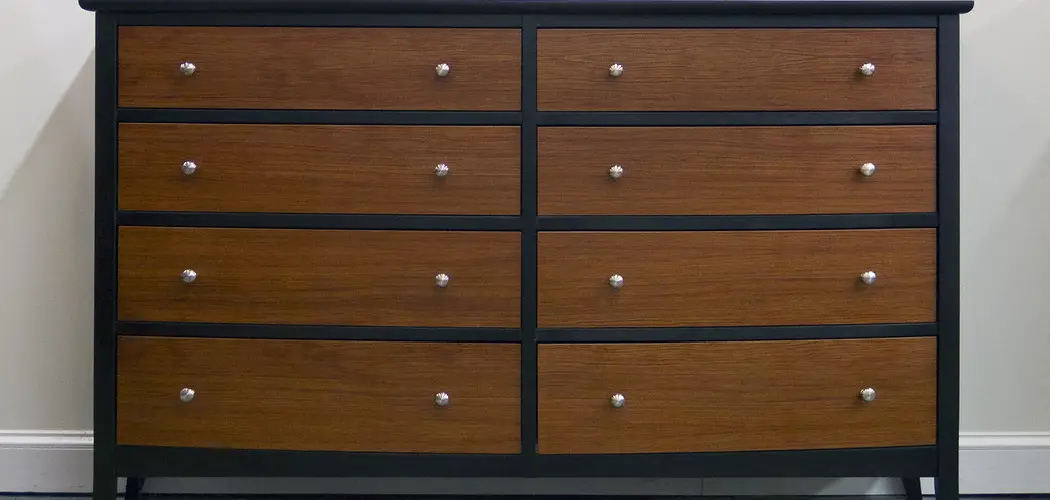Staining your dresser might seem daunting, but it doesn’t have to be! Staining wood lends a certain richness and beauty that only comes from taking the time to finish your furniture with care. With a few tips and tricks, you can transform the look of any room by creating an updated piece without too much hassle.
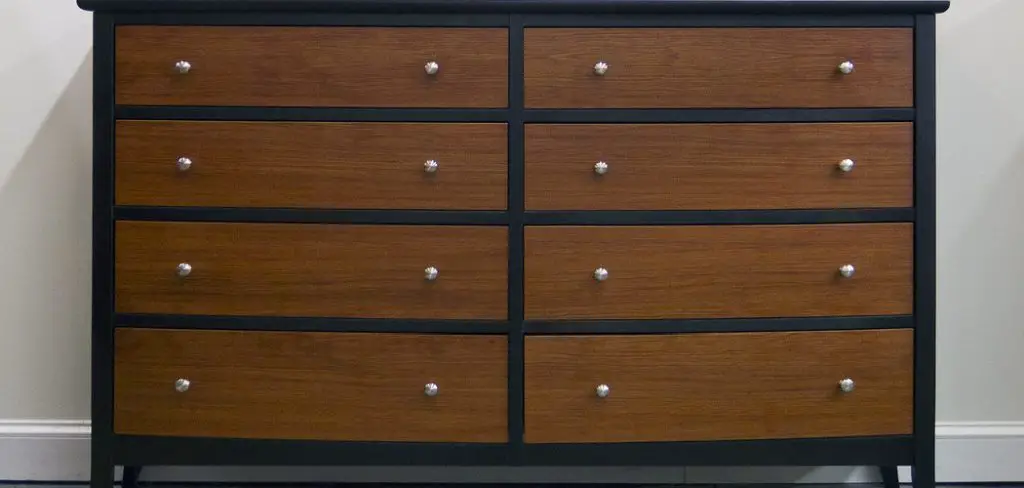
This guide will give you all the essential information necessary for how to stain dresser while still allowing you to make it into something truly unique. Read on for helpful advice about preparing, applying, and caring for wood stains on your dresser!
Step-by-step Guidelines on How to Stain Dresser
Step 1: Preparing the Dresser
Before you begin, make sure your dresser is free of dirt and dust. A clean surface will ensure a better finish when you apply the stain. If your dresser has been previously painted or varnished, you’ll need to remove that first by sanding it lightly with medium-grade sandpaper (120 grit). Make sure to wipe down the dresser afterward to remove all dust residue.
Step 2: Applying the Stain
Once your dresser is prepped and ready, you can start applying the stain. Many stains come in a variety of colors to choose from, but it’s important to make sure you buy the right type for your project. For example, if you are staining a wood dresser, then you should use a water-based stain. Oil-based stains are better for furniture with areas of hard-to-reach crevices or intricate detailing.
To apply the stain, dip a foam brush into the can and start in the middle of the dresser’s largest surface sections, then work outward in smooth strokes. You may need to apply multiple coats depending on how deep of a color you desire. Let the stain dry in between coats.
Step 3: Finishing Touches
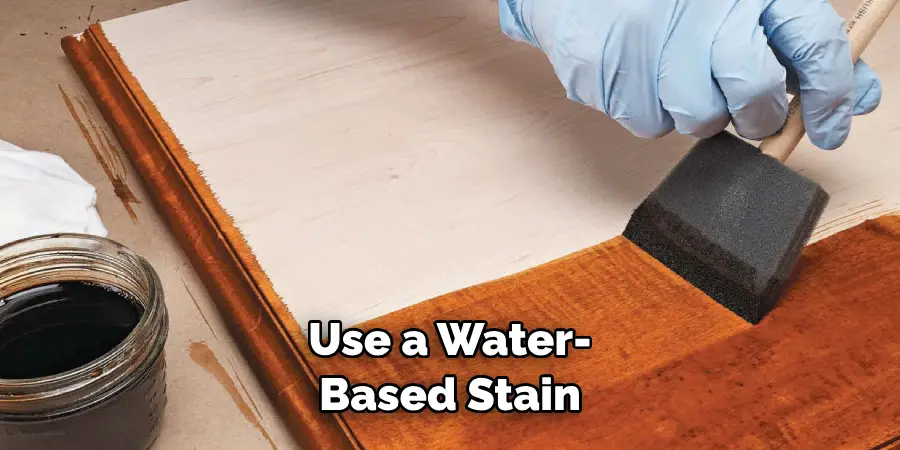
Once all of the stain has been applied, it’s time to seal and protect your work. A polyurethane finish will help keep your stained dresser looking sharp for years to come. Make sure to apply at least two coats of polyurethane, allowing each coat to dry before moving on to the next. Make sure to follow the manufacturer’s instructions for best results.
Step 4: Maintaining Your Dresser
Maintaining your stained dresser is about more than just a regular dusting or polishing. You’ll want to check regularly for any scratches, water rings, or other damage on the surface and take care of it immediately by lightly sanding and re-staining if necessary. This will help keep your dresser looking like new for many years to come.
Following these steps can help you create a beautiful stained dresser that will last for many years of enjoyment. With just a little bit of effort and some patience, you’ll have a unique piece of furniture that adds style and elegance to any room!
Additional Tips and Tricks to Stain Dresser
- Always work in a well-ventilated area to reduce the exposure to toxins from the stain or paint.
- Make sure that you protect your clothes by wearing an old shirt and gloves while staining.
- If you want to have an even color, use a brush with natural bristles – they will spread out the stain more evenly than synthetic ones.
- If you’re staining a drawer, make sure to remove it first before applying the stain. Doing this will ensure that the stain is applied evenly and with minimal mess.
- After applying the stain, use a rag to wipe off any excess – this will help create an even color when it dries.
- If you’re using a paint sprayer, mask off any areas that you don’t want painted.
- When the stain is dry, use sandpaper to lightly rub down the surface for an even finish.
- To protect the dresser from scratches and dirt, apply a coat of sealant or varnish after staining it. This will also help keep the color vibrant.
- Finally, make sure that the dresser is completely dry before you put it back in your home. This will help prevent any staining residue from transferring to other items in your house.
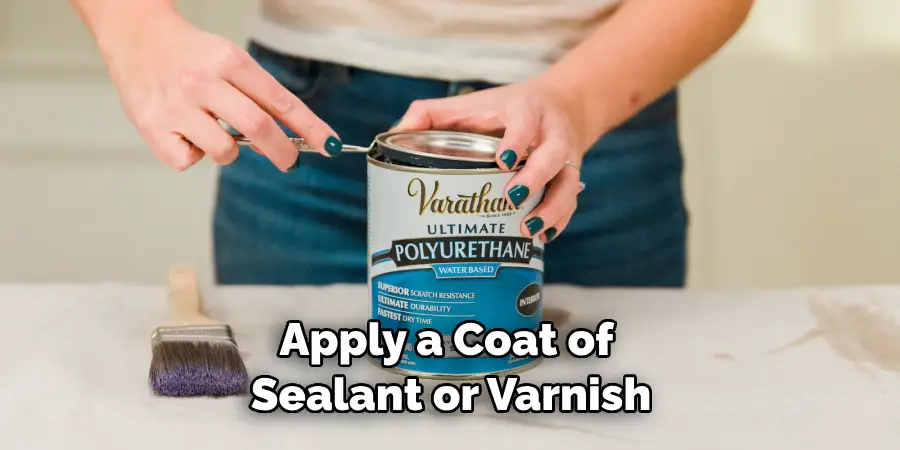
Following these tips and tricks will help you achieve the perfect stain job for your dresser. With a bit of patience and the right materials, you’ll be able to create a beautiful piece of furniture that will last for years to come!
Things You Should Consider to Stain Dresser
1. Choose the right stain. Before you begin staining your dresser, make sure that you select a quality product to ensure the best results. Evaluate both water- and oil-based stains to determine which is better suited for your particular project.
2. Prepare the surface. Once you have chosen the appropriate stain, take time to prepare your dresser by cleaning and sanding the surface. Make sure to wipe away all dust when finished, as this will help create a smooth finish.
3. Apply the stain evenly. Use a brush, foam applicator, or cloth to apply the stain in long, even strokes across the dresser’s surface. Work your way from top to bottom in sections, making sure to wipe away any excess stains.
4. Allow the stain to dry. Before applying a finish coat of varnish or lacquer, it is important to allow the stain to dry completely so that it adheres properly and evenly. Follow the manufacturer’s instructions for drying time and set aside an area with good ventilation for the project.
5. Apply a top coat. Once the stain is dry, apply an even layer of varnish or lacquer over the entire dresser. This will help protect and seal the wood to ensure that it lasts for years to come. Again, follow the manufacturer’s instructions for drying time before using your newly stained dresser.
6. Maintain your dresser. To keep your stained dresser looking its best, it is important to properly maintain the wood. Use a soft cloth and mild cleaner to wipe away dust and dirt on a regular basis, and use furniture oil when necessary to prevent drying or cracking of the finish.

Following these considerations and tips should help you to successfully stain your dresser. With proper preparation and care, you can create a beautiful piece of furniture that will last for years to come.
Common Mistakes to Avoid for Staining Dressers
- Not sanding the surface of your dresser before applying a stain – Before you start staining, make sure to sand down any rough spots on the wood. This will help ensure that the stain is applied evenly and gets absorbed uniformly into the wood for a professional-looking finish.
- Not testing a sample first – Before you apply a stain, you should always test it on a sample patch of the same wood that you’re using. This will let you see if the color and finish are what you were expecting before applying it to the entire dresser.
- Not pre-treating or conditioning – Pre-treatment and conditioners help ensure that the stain takes evenly by sealing in moisture and allowing the wood to absorb the stain evenly.
- Not using proper tools – Applying a stain requires more than just a brush; you will also need sandpaper, rags, sponges, and other materials for prepping and cleaning up afterward. Make sure that you have everything on hand before starting your project.
- Not wiping off excess stain – After you’ve applied a color, you should always wipe off any excess with a cloth in the direction of the wood grain. This will help prevent it from pooling and create an even finish on your dresser.
- Not sealing after staining – Finally, use sealant or polyurethane to protect the finish of your dresser. This will help keep it looking good for years to come.
These are some of the most common mistakes that people make when staining a dresser, but with careful preparation and planning, you can avoid them and get great results. With a little patience and attention to detail, you’ll have an amazing-looking dresser in no time! Happy staining!
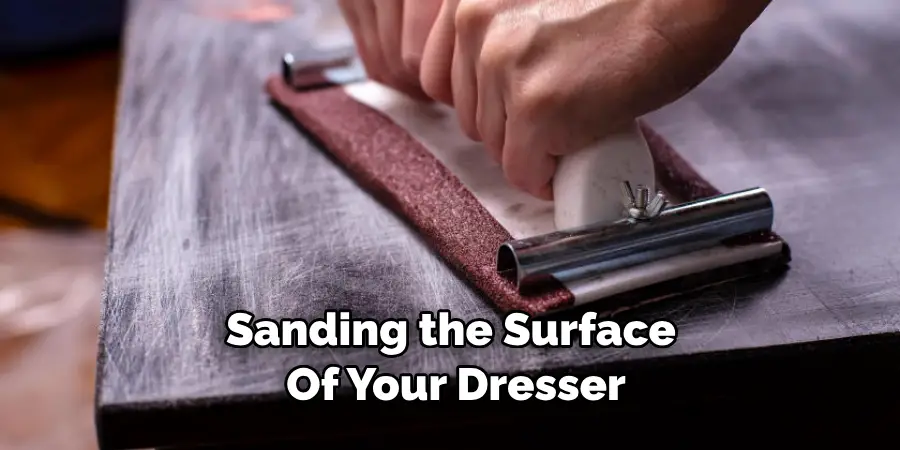
Precautions Need to Follow for Staining Dresser
- Before you start working on staining your dresser, make sure it is thoroughly cleaned. Dust, dirt and other debris can affect the absorption of stain and may cause an uneven finish.
- Also, ensure that all hardware has been removed from the dresser before beginning the staining process.
- Make sure to wear gloves for protection when handling chemicals or wood stains.
- Ensure that you are working in a well-ventilated space and wear a mask, if necessary, to avoid inhaling dust or other particles.
- To ensure the best possible finish when staining your dresser, use high-quality materials. Low-quality products can result in an uneven finish or even damage to the wood of the dresser.
- Test the wood stain color on a hidden area of the dresser before applying it to the entire piece. This will help you ensure that you are happy with the color and finish of your dresser once completed.
- When staining, use long, even strokes and work in small sections at a time to avoid any streaks or inconsistencies in the finish.
- As you are working, clean up any excess stains or debris as necessary to ensure a smooth finish when completed.

Following these precautions will help ensure that your staining job is done properly and that you are happy with the end result. If you follow these steps, you can have a beautiful stained dresser that will last for years to come!
Frequently Asked Questions
What Type of Paint Do I Need to Stain My Dresser?
You will need a water-based or an oil-based paint that is formulated specifically for furniture. Be sure to read the instructions carefully and follow all safety precautions before starting the project.
How Do I Prepare the Wood?
Before you begin, make sure to sand down the surfaces of your furniture with fine-grit sandpaper. This will help ensure that any dirt and grime are removed so that your finish looks more even and professional. Make sure to follow up with a tack cloth or damp rag to remove any dust left behind.
What is the Best Way to Apply the Stain?
The best way to apply stain is with a brush or rag, depending on how much coverage you need. Start by applying the stain evenly and move up and down in a slow, circular motion. When you are finished, let the stain sit for 10-15 minutes before wiping off any excess with a clean rag.
How Do I Seal the Finish?
Once your stain has completely dried, it is important to seal the finish to protect it from dirt and grime. Use a polyurethane sealant or lacquer to seal in the color and provide extra protection for your dresser. Make sure to follow all directions carefully and apply multiple coats for an even finish.
How Can I Maintain My Stained Dresser?
To keep your dresser looking great, make sure to dust regularly with a microfiber cloth. You can also use a wood cleaner or polish to help protect the finish and keep it looking new.

Avoid using any abrasive cleaning supplies, as these may damage the stain or sealant. Finally, never leave water sitting on your furniture for too long, as this can cause stains and discoloration. With proper care and maintenance, your stained dresser can look beautiful for years to come!
Conclusion
Staining your dresser doesn’t have to be overwhelming and with this article, you feel as though you have a better understanding of the process now! From preparing the wood to mixing the stain, following these steps is a great way to quickly transform your dresser.
The key to success is taking things one step at a time and ensuring each step is done precisely and thoroughly. If you’ve been looking for tips on how to stain your dresser, then you are now well-equipped with the knowledge to do so!
Don’t be scared to take on this project – it can easily be done in a couple of hours and lead to beautiful results that will update any space. Take your time and soon enough your dresser will look like it was professionally stained – that was easy, right? Get started today on learning how to stain dresser!

